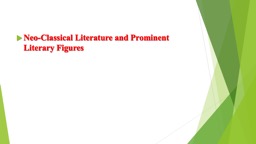

NeoClassical Poetry Representative poets of the age are Dryden Goldsmith Pope and Milton Each poet surfaced one among the three segments of the neoclassical poetry Restoration Age ID: 1019331
Download Presentation The PPT/PDF document "Neo-Classical Literature and Prominent L..." is the property of its rightful owner. Permission is granted to download and print the materials on this web site for personal, non-commercial use only, and to display it on your personal computer provided you do not modify the materials and that you retain all copyright notices contained in the materials. By downloading content from our website, you accept the terms of this agreement.
1. Neo-Classical Literature and Prominent Literary Figures
2. Neo-Classical PoetryRepresentative poets of the age are- Dryden, Goldsmith, Pope and Milton. Each poet surfaced one among the three segments of the neoclassical poetry- Restoration Age, Augustan Age, and Age of Transition.
3. John Milton and John DrydenJohn Milton and Dryden were prominent poets during the Restoration Age(1660-1700). Milton is known for his Paradise Lost, an heroic poem that follows the tradition of Virgil and Homer. Samson Agonistes is another notable work by Milton in Restoration age. John Dryden’s poetry was built around reason, logic and matter of fact. Often, he attempted to form his poetry with the couplet, alexandrine and triplet. For instance, in his allegorical poem The Hind and the Panther, he uses heroic couplets to write down about religion after he converted to Catholicism.
4. Alexander Pope(1668-1774) Pope was the sole predominant figure within the poetry of 18th century. He was the representative poet of his century. Pope’s first and most vital claim to greatness is that the incontrovertible fact that he’s pre-eminently the poet of his age like Chaucer and Tennyson. His notable poems are- Windsor Forest, Pastorals, Messiah, Essay on Criticism, Rape of the Lock, Essay on Man, Dunciad etc.
5. Matthew Prior (1664-1721)Matthew Prior was another poet of the classical age. Prior’s longest humorous poem, Alma; or The Progress of Mind. This along with his most ambitious work Solomon and Other Poems on Several Occasions, was published by subscription in 1718.
6. Neo-Classical ProseAs Neo-Classical age is also called the “Age of Prose Reason” that’s why neoclassical prose is more developed as compared to poetry. Dryden was a poet but we find in his poetry, characteristics of good prose-neatness, lucidity, uniformity and balance. Matthew Arnold declared that Dryden and Pope were the classics of prose not of poetry.
7. Jonathan Swift (1667-1745)Swift became one of the greatest writers of the Neo-Classical age. His important works are The Battle of Book, A Tale of Tub, The Whigs for the Tories, Gulliver’s Travels etc.
8. Joseph Addison (1672-1719) Addison wrote many political pamphlets but didn’t get fame as a pamphleteer. He became famous only through his essays. His important prose writings are contained in The Tattler and the Spectator,
9. Richard SteeleSir Richard Steele, pseudonym Isaac Bickerstaff, ( 1672-1729), English essayist, dramatist, journalist, and politician, best known as principal author (with Joseph Addison) of the periodicals The Tatler and The Spectator.
10. Criticism in Neo-Classical EraAt the beginning of this era, John Dryden was the major critic whereas at the end of it was Dr. Samuel Johnson. An Essay on dramatic poesyPreface to Shakespeare
11. Rise of NovelModern novel began to develop during the 18th century. The term novel derives from the Latin ‘novus’ and from the Italian ‘novella’. It was in opposition to the term ‘Romance’ referring to a chivalric story in verse. It was used to refer to a prose fiction which was new because it told stories about recent events.
12. Daniel DefoeDaniel Defoe 1660 –1731) was an English trader, writer, journalist, pamphleteer and spy. He is most famous for his novel Robinson Crusoe, published in 1719, which is claimed to be second only to the Bible in its number of translations.[2] He has been seen as one of the earliest proponents of the English novel, and helped to popularise the form in Britain with others such as Aphra Behn and Samuel Richardson.[3] Defoe wrote many political tracts and was often in trouble with the authorities, and spent a period in prison.
13. Four Wheels of NovelRichardson, Fielding, Smollet, and Sterne are known as the- four wheels of novel. they brought this new genre to such maturity that it became the glory of England.
14. Samuel Richardson(1689-1761) Samuel Richardson is called the father of English novel. His three main works are- ‘Pamela’ or ‘Virtue Rewarded’(1740), ‘Clarrisa’(1747-48) and ‘The History of Sir Charles Grandison’(1754), these three novels form a trilogy of a kind and deal respectively with humble life, middle class life and with high class.
15. Henry FieldingHenry Fielding wrote ‘Joseph Andrews’(1742), ‘Tom Jones’(1749), ‘Amelia’(1751) and ‘Jonathan Wild’(1743). Henry Fielding’s very first novel Joseph Andrews’ was intended to be parody of Richardson’s ‘Pamela’ of its prudish morality and sentimentalism. Fielding is known for his picaresque novel, ‘Tom Jones’.
16. Tobias SmollettTobias Smollet’s novels are also picaresque in style. They include ‘Humphrey Clinker’(1771), and ‘Roderick Random’(1748). The plot is loose and formless and it has no romantic relationship to character. His characters are sordid and vicious, typical of English life in that period. Tobias Smollett also added satiric characters to his novels.
17. Laurence SterneLaurence Sterne is the last among the four wheels of English novel. Laurence Sterne wrote the life and opinions of ‘Tristan Shandy’(1760-67) and ‘The Sentimental Journey through France and Italy’(1768). His novels are essentially stories gripping in their interest but without story end, without story beginning and without story connection or middle.
18.
19. References Web Sources The Oxford Companion to English Literature, ed. by M. Drabble (1985); The Oxford Anthology of English Literature, ed. by F. Kermode and J. Hollander (2 vol., 1973)